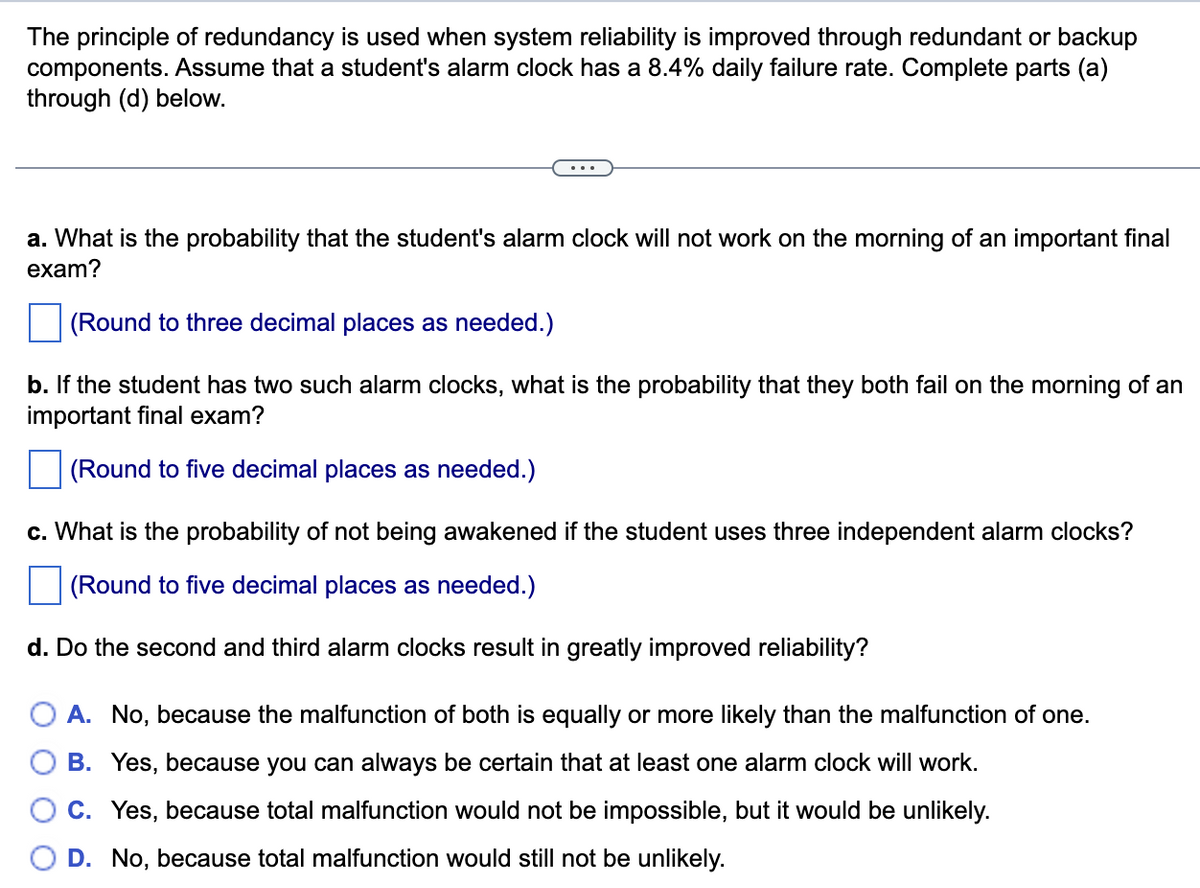The principle of redundancy is used when system reliability is improved through redundant or backup components. Assume that a student's alarm clock has a 8.4% daily failure rate. Complete parts (a) through (d) below. ... a. What is the probability that the student's alarm clock will not work on the morning of an important final exam? (Round to three decimal places as needed.) b. If the student has two such alarm clocks, what is the probability that they both fail on the morning of an important final exam? |(Round to five decimal places as needed.) c. What is the probability of not being awakened if the student uses three independent alarm clocks? (Round to five decimal places as needed.) d. Do the second and third alarm clocks result in greatly improved reliability? A. No, because the malfunction of both is equally or more likely than the malfunction of one. B. Yes, because you can always be certain that at least one alarm clock will work. C. Yes, because total malfunction would not be impossible, but it would be unlikely. D. No, because total malfunction would still not be unlikely.
The principle of redundancy is used when system reliability is improved through redundant or backup components. Assume that a student's alarm clock has a 8.4% daily failure rate. Complete parts (a) through (d) below. ... a. What is the probability that the student's alarm clock will not work on the morning of an important final exam? (Round to three decimal places as needed.) b. If the student has two such alarm clocks, what is the probability that they both fail on the morning of an important final exam? |(Round to five decimal places as needed.) c. What is the probability of not being awakened if the student uses three independent alarm clocks? (Round to five decimal places as needed.) d. Do the second and third alarm clocks result in greatly improved reliability? A. No, because the malfunction of both is equally or more likely than the malfunction of one. B. Yes, because you can always be certain that at least one alarm clock will work. C. Yes, because total malfunction would not be impossible, but it would be unlikely. D. No, because total malfunction would still not be unlikely.
Chapter8: Sequences, Series,and Probability
Section8.7: Probability
Problem 11ECP: A manufacturer has determined that a machine averages one faulty unit for every 500 it produces....
Related questions
Question
4.

Transcribed Image Text:The principle of redundancy is used when system reliability is improved through redundant or backup
components. Assume that a student's alarm clock has a 8.4% daily failure rate. Complete parts (a)
through (d) below.
a. What is the probability that the student's alarm clock will not work on the morning of an important final
exam?
(Round to three decimal places as needed.)
b. If the student has two such alarm clocks, what is the probability that they both fail on the morning of an
important final exam?
(Round to five decimal places as needed.)
c. What is the probability of not being awakened if the student uses three independent alarm clocks?
(Round to five decimal places as needed.)
d. Do the second and third alarm clocks result in greatly improved reliability?
O A. No, because the malfunction of both is equally or more likely than the malfunction of one.
B. Yes, because you can always be certain that at least one alarm clock will work.
C. Yes, because total malfunction would not be impossible, but it would be unlikely.
D. No, because total malfunction would still not be unlikely.
Expert Solution
This question has been solved!
Explore an expertly crafted, step-by-step solution for a thorough understanding of key concepts.
This is a popular solution!
Trending now
This is a popular solution!
Step by step
Solved in 2 steps with 1 images

Recommended textbooks for you

